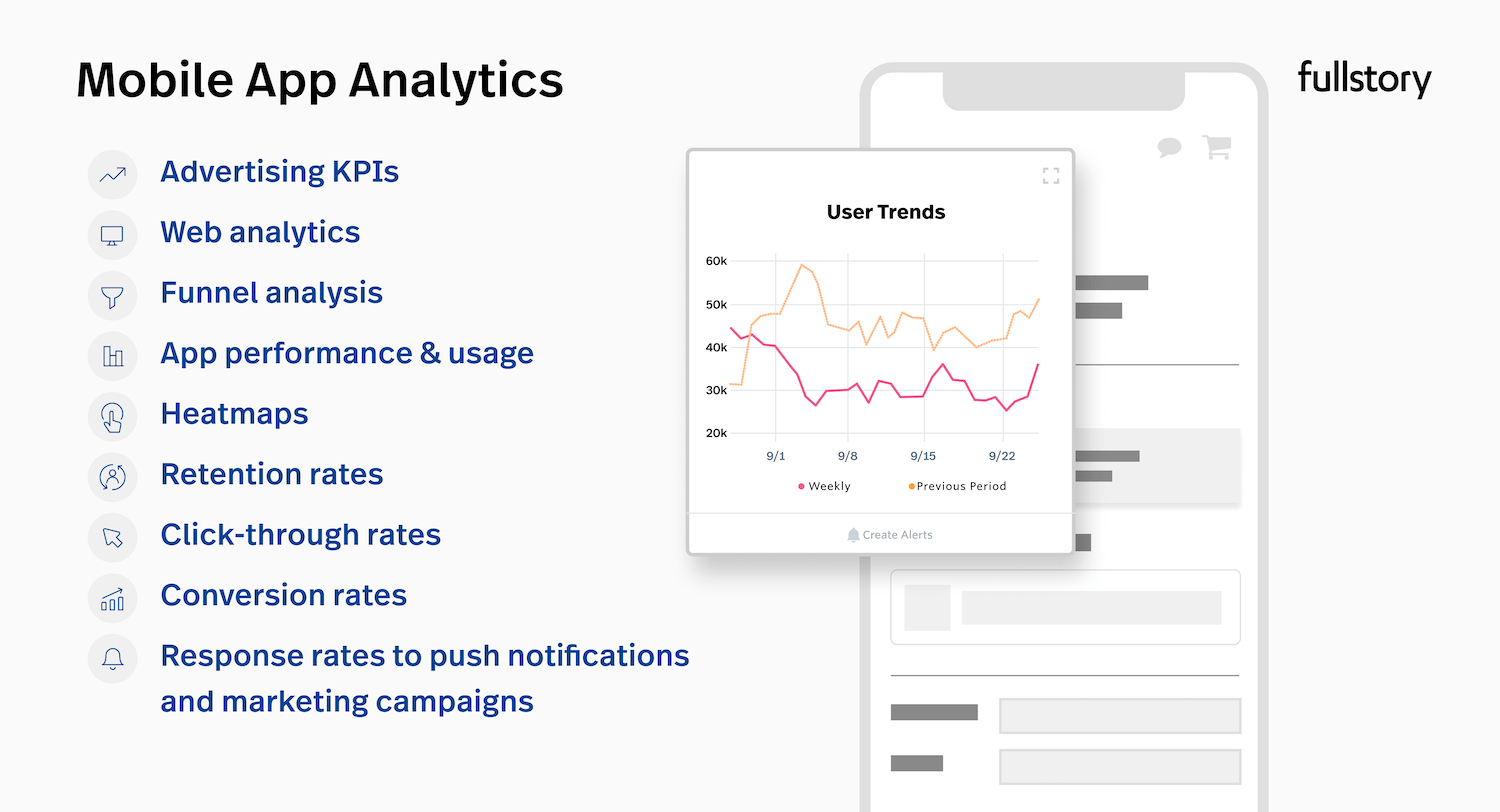Mobile analytics—or mobile app analytics—is both something that you gather and something that you practice.
It has three parts:
Data collection
Data analysis
Data interpretation
"Data," in this case, refers to the way users use and interact with your app, providing crucial analytics for mobile app optimization and user experience improvements.
If applied well, you can encourage more users to download your mobile app, track mobile app usage and user experience to keep users engaged for longer periods, and encourage return user sessions.
In other words, effectively utilizing mobile app analytics—gathering real-time insights and building improvements—is often business-critical.
Examples of mobile analytics
Any metrics around user devices (whether Android or iOS) are a form of mobile analytics. Common examples include:
Advertising KPIs
Web analytics
An app’s performance and app usage
Retention rates
Click-through rates
Conversion rates
Response rates to push notifications and marketing campaigns
These insights let teams maximize ROI by making informed decisions about new directions and initiatives.

Why do companies use mobile analytics?
Mobile analytics gives companies insights into their users’ behaviors and preferences that would have been inaccessible only a few years ago. These insights can help you refine your product based on how users actually interact with it.
For example, if analytics show that users rarely access a given feature, you may want to eliminate support for that feature.
You also may be able to identify pain points that cause frustration or even lead to users to delete your app. Perhaps certain advertisement formats cause higher-than-average bounce rates. All of this information can help you fine-tune your product at a granular level, helping you constantly improve your service.
Fortunately, modern analytics come in the form of app analytic tools. These applications create a single unified dashboard that collects data, draws conclusions, makes predictions, and visualizes trends automatically.
How are mobile analytics different from web analytics?
The difference between mobile analytics and web analytics can be found in the name: mobile analytics gathers data from mobile apps, while web analytics or product analytics pull information from users’ experiences on both desktop and mobile websites.
There is a lot of data applicable to websites and web analytics that don’t necessarily apply to mobile apps, including:
Online ads
Clicks
Search engine optimization (SEO)
Mobile analytics focuses on unique users and captures their demographics, behaviors, and interactions within an app’s user experience. It then groups that information with that of similar users to better track trends.
The best of mobile and web analytics: Fullstory's Behavioral Data Platform
Fullstory’s groundbreaking platform delivers qualitative and quantitative insights to help you deliver both stand-out mobile and web experiences.
Get a demo and see how you can create a perfect digital experience and boost your bottom line.
Why are mobile analytics important?
Mobile browsing officially passed desktop use in 2016–and now the average consumer spends more than four hours daily in apps.
Naturally, this means the amount of behavioral data they generate represents a huge opportunity for companies to optimize their target audiences.
Unfortunately, they have stiff competition. The major app stores host 6.5 million separate applications. Mobile analytics help gather detailed insights into users’ experiences (UX), their behavior, and the best ways to improve retention after conversion.
Without analytics, businesses can’t fully understand what their customers are looking for.
With easy access to competition a few taps away, it’s critical to deliver rich, enjoyable, and convenient experiences to keep existing customers and attract new ones. Just consider this: based on a 2022 Fullstory survey, 44% of users are likely to leave a website if they run into a problem or frustration.
In short, app analytics is no longer a nice to have. This type of data capture and comparison is mandatory if you want your app to compete.
How do mobile analytics work?
If manually gathering and sorting information from each one of your thousands of individual users sounds like a chore, that’s because it is.
By integrating proprietary analytics code into your existing mobile app, teams can make information gathering easy and scalable. Not only do these programs then report valuable insights to a centralized dashboard, they anonymize user information before logging it to protect your customers.
While gathering data in real-time, analytics dashboards collect information and translate and visualize your data. With a decentralized analytics platform, it’s easy to keep everyone in the loop, which turns meetings from a reporting requirement into a collaborative, real-time decision-making environment.
What are the types of mobile analytics?
Every business is different, so every business needs different data to make the best decisions–and not all mobile analytics platforms are created equal. Understanding your needs and short- and long-term goals will help focus on one or more varieties of mobile analytics.
Also keep in mind, some product analytics tools—for example, Fullstory’s Mobile App Analytics—feature many different types of mobile analytics.
Mobile advertising analytics
As companies pour thousands of dollars into mobile marketing, it’s important to see just how consumers engage with your advertisements.
App monetization analytics
It’s no secret that customers prefer free apps over paid ones. In the current landscape, most businesses offer app downloads for free and create revenue by:
Monetizing with app-to-app advertising
Offering premium in-app currency that costs real money
Providing a shop for in-app purchases
Renting streaming media
The monetization options you choose will vary depending on your verticals. By tracking them carefully, you can review user engagement with your monetization options and understand how you can encourage users to spend more.
Performance analysis
Mobile analytics software shows you who your app works for—or doesn’t. They locate bugs that might appear on iOS but not Android (or vice versa), catch performance issues with crash reporting, and find slowdowns in load times that can damage your sales.
In-app engagement analytics
If you can see how long your customers spend in which parts of the app, you can:
Find bottlenecks in your checkout process
Locate performance issues
Emphasize the most valuable parts of your app
The importance of in-app engagement analytics
When it comes to creating a pleasurable experience for your users, in-app engagement tools are a business’ best friend. In-app engagement analytics help design and UX teams identify user friction and solve user issues.
But customers not engaging with your app isn’t something you can handle internally. Only analytics that tell you when in the process customers lose touch can assist you in fixing the issue.
Regardless of scale, the product managers, developers, and UX teams that make apps only see a fraction of users leaving reviews for their applications. While reviews are a great way to find feedback, the odds are good that the silent majority will never share the reasons they left your app—they’ll just go.
By doing the hard work for them, you can get the information you need to give them a better experience in the future.
How do different teams use mobile analytics?
Just as different businesses use the insights they gain from mobile analytics in different ways, different departments within a company use different information from the analytics they choose to gather:
Product teams make informed decisions about the app
UI and UX teams improve the overall user experience
Technical teams squash bugs Marketing teams analyze current campaigns and plan future ones
Management compares app revenue to web or physical locations
For this reason, it’s important to gather input from multiple teams and perspectives while establishing the code base and internal infrastructure to gather the mobile analytics that powers decision-making. With each team empowered by information tailored to them, everyone is able to make the best decisions.
Mobile analytics for product teams
Product managers can review analytics to find purchasing and funnel trends before making decisions about changes in product lines, inventories, and discontinuations.
They can even gather insights about the types of customers who buy specific products and pass the information to marketing to improve audience targeting at the advertisement stage.
The real-time updates that mobile analytics afford mean managers can see improvements immediately or find problems in any step of the process for any type of user in any part of the world.
Mobile analytics for marketing teams
Just as web analytics provide valuable information for marketers, mobile analytics give marketers incredible insights into the effects of their campaigns.
Marketers can track:
App-related campaign effectiveness (attribution)
New user installations
The purchasing behavior of new and existing users
Time spent in app
Sales funnel performance and conversions
Cart abandonment rates
Just like product managers, marketing teams monitor sales funnel and conversion rates to determine how best to encourage new and existing consumers to spend money in the app.
Mobile analytics for UI and UX teams
Since design trends change constantly and customers update their preferences regularly whether they realize it or not, UI and UX teams can use mobile analytics to track customer engagement and preferences.
Whether focus-testing or A/B testing design changes or tailoring landing pages to consumer interests with the help of machine learning and demographic identification, UI and UX teams use the immediate, real-time, and unconscious feedback every user gives them to make the experience as smooth as possible.
Mobile analytics for technical teams
The backend is just as intimately linked to the user experience as the UX team. If the app malfunctions for a certain population of users, then the company loses both its mobile revenue and its goodwill for future purchases. An app that crashes over and over again will be uninstalled swiftly.
With analytics to identify priorities, technical teams can improve app engagement for the best possible user experiences and prevent problems like security vulnerabilities from becoming full-blown PR catastrophes.
The KPIs you should track for your mobile app analytics
While the data you gather will differ between verticals and teams, here are a few common factors to consider and what they help you understand:
Customer retention rates to predict future spend
Lifetime value of customers to assess total worth
User growth rates to assess marketing initiatives
Uninstallation sequences to find opportunities for improvement
When combined with specialized KPIs for each team, the right set of mobile app analytics can transform your mobile initiatives with masterfully informed decisions.
Mobile app analytics tools
With a variety of tools to choose from, it should come as no surprise that SaaS providers are jumping at the chance to provide quality mobile analytics.
Amplitude
Amplitude uses cross-platform analytics to help teams review multiple customer bases
Flurry
Flurry is a lightweight tool typically suited for businesses on a budget.
Fullstory
Fullstory’s mobile app analytics is second to none, boasting seamless data autocapture, high-fidelity session replay, crash and error reporting, users journeys and more–all while protecting user privacy.
A groundbreaking platform that has been committed to user privacy from the very start, Fullstory does just what its name implies—it gets you the full story every single time.




